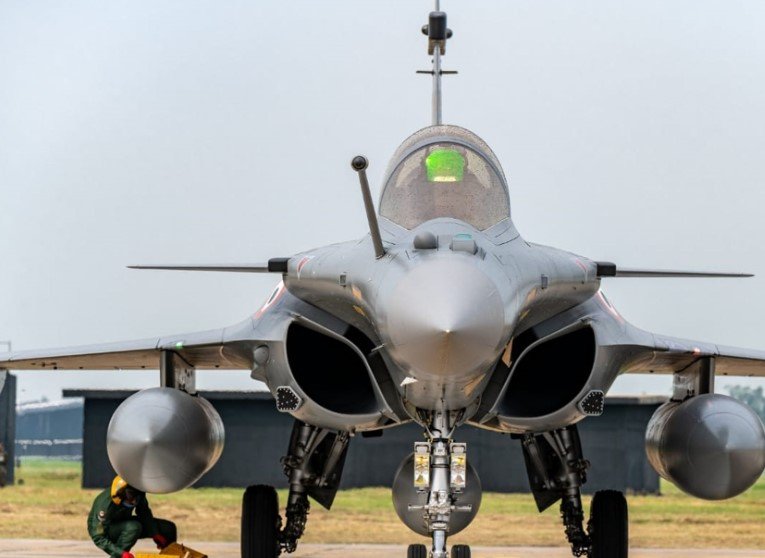India has indeed lost a Rafale fighter jet — but not in battle. That’s the word straight from Dassault Aviation’s top boss. Eric Trappier, Chairman and CEO of the French aerospace giant, broke his silence on the incident, confirming the loss but stressing there was no enemy engagement.
While New Delhi has kept a tight lid on the matter, Trappier’s remarks have stirred both concern and curiosity in military circles. The revelation comes amid a surge of posturing between India and Pakistan following the controversial Operation Sindoor.
Dassault Speaks: Jet Lost During Training, Not War
The Rafale didn’t fall to enemy fire — that’s the key message from Trappier. Speaking to a French defence publication, he said the mishap happened at an altitude of over 12,000 metres during what he called an “extended training mission.” There was no combat, no missiles, no radar locks. Just a technical glitch, at least for now.
That one sentence — “no enemy engagement involved” — does a lot of heavy lifting. Especially after Pakistan’s dramatic claims last month that they had shot down six Indian aircraft, including Rafales.
The IAF hasn’t publicly confirmed the incident yet. But insiders suggest a hush-hush internal probe is underway.
One officer, requesting anonymity, said: “We’re aware of the media reports and the CEO’s remarks. That’s all we’re going to say for now.”

The Pakistan Angle: Claims and Counterclaims
The drama didn’t start with Dassault’s admission. It started weeks ago with Islamabad’s loud assertions that Pakistani forces downed multiple Indian jets during Operation Sindoor.
India’s response? A flat-out rejection.
Chief of Defence Staff General Anil Chauhan, speaking at the Shangri-La Dialogue in Singapore last month, didn’t mince words. “Absolutely incorrect,” he said, dismissing Pakistan’s story as fiction wrapped in bravado.
He didn’t go into specifics about any aircraft losses, but he did admit that India had “suffered some setbacks.” That carefully worded line raised eyebrows, though most experts took it as a reference to minor equipment or logistical issues.
And here we are now, with Dassault confirming what India would rather have kept quiet.
What We Know About the Rafale Incident
Details remain thin, but here’s what’s trickled out so far:
-
The jet reportedly crashed during a high-altitude training sortie.
-
It was not downed by enemy action or electronic warfare.
-
No fatalities have been reported, suggesting the pilot may have ejected safely.
-
The Indian government has yet to officially comment.
The exact location? Still under wraps. But aviation watchers believe the sortie may have taken place near the Line of Actual Control, or possibly even over friendly airspace near Ladakh.
One officer, off the record, quipped, “It didn’t fall out of the sky in Islamabad, if that’s what people are imagining.”
Rumors, China, and the Rafale PR Battle
Here’s where things get murky — and geopolitical.
A report by the Associated Press dropped another bombshell on Monday. According to French military and intelligence officials, China has been quietly nudging its embassies to question the Rafale’s effectiveness.
The backdrop? India’s recent use of Rafales during cross-border strikes. Beijing reportedly saw an opportunity to chip away at Dassault’s credibility — especially in regions where French fighter jets are competing with Chinese ones for contracts.
One official told AP, “This is a classic perception war. China’s playing the long game.”
The insinuation is that Beijing is seeding doubts about the Rafale’s combat-readiness — precisely because the jet has become a symbol of India’s offensive edge.
India’s Silence Is Strategic — But Risky
So why hasn’t the Indian Air Force come clean?
Part of it may be timing. With tensions still simmering along the western border and an election season approaching, no one in South Block wants to be the bearer of bad news.
There’s also the issue of morale. Admitting the loss of a premium fighter jet — bought after years of debate and billions in public funds — isn’t easy.
But staying quiet has its risks too. It creates space for misinformation, stokes speculation, and feeds conspiracy theories on both sides of the border.
Even defence analysts who sympathize with the need for confidentiality are beginning to raise eyebrows.
“Silence is sometimes golden, but in this case, it’s becoming deafening,” said former Air Marshal Anil Chopra.
How Much Does A Rafale Actually Cost?
Let’s take a look at why this matters financially too. The Rafale is no toy. India paid top rupee for these jets, and every unit counts.
Here’s a quick cost breakdown:
| Rafale Fighter Jet Component | Estimated Cost (INR) | Notes |
|---|---|---|
| Base Aircraft (per unit) | ₹700 crore | Excludes weapons and logistics |
| Weapon Systems & Sensors | ₹200 crore | Includes SCALP, Meteor, etc. |
| Maintenance Package | ₹150 crore | 5-year support deal |
| Training and Simulators | ₹100 crore | For pilots and ground crew |
| Total Estimated Cost | ₹1,150 crore | Per aircraft |
So yeah — losing even one hurts.
Strategic Blow or Just Bad Luck?
For now, this doesn’t change the big picture. India still has a strong fleet of 36 Rafales, many of which are now deployed across key airbases in Ambala and Hasimara.
But this incident — and the swirl of silence around it — has put a dent in the aircraft’s untouchable aura.
And it also reignites debate about India’s ageing air fleet, its procurement strategies, and whether putting so many eggs in a French-made basket was a smart move after all.
Was this just a fluke, a one-in-a-million technical mishap? Or a sign that even the most advanced jets aren’t immune to failure?
Time — and perhaps a clearer IAF statement — will tell.
